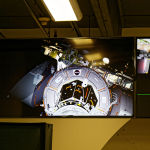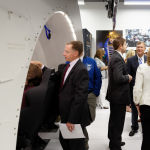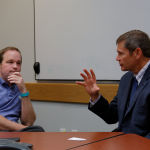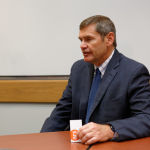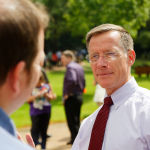Since I was a young child Mars held a special fascination for me. It was so close and yet so faraway. I have never doubted that it once had advanced life and still has remnants of that life now. I am a dedicated member of the Mars Society,Norcal Mars Society National Space Society, Planetary Society, And the SETI Institute. I am a supporter of Explore Mars, Inc. I'm a great admirer of Elon Musk and SpaceX. I have a strong feeling that Space X will send a human to Mars first.
Thursday, June 30, 2016
Planetary Radio LIVE Webcast of LADEE's Launch to the Moon
Planetary Radio LIVE Webcast of LADEE's Launch to the Moon: Join lunar scientist Dr. David Paige, LADEE EPO Coordinator Brian Day, Bill Nye, and the Society's Mat Kaplan and Dr. Bruce Betts in front of a crowd of 150 space fans as they celebrate LADEE's launch to the Moon.
Wednesday, June 29, 2016
NASA Orders First Crewed Space-X Dragon Capsult o ISS
https://thespacereporter.com/2016/06/nasa-orders-first-crewed-spacex-mission-iss/
Space-X Rocket Explosion Caused $118 Million In Cargo To Be Lost
NASA: $118 million in cargo lost in 2015 SpaceX explosion
NASA's inspector general said Tuesday that an explosion of a SpaceX rocket last June destroyed a docking adapter crucial to converting the International Space Station for manned missions.
The report, which said the explosion cost $118 million in cargo, came on the one-year anniversary of the Falcon 9 rocket exploding just minutes after launch on Florida's Space Coast on June 28, 2015.
In the report, the inspector general admonished NASA for not being more specific about risks associated with resupply launches, meaning NASA management cannot properly evaluate risks.
The one-size-fits-all approach, which, according to the report, essentially places all commercial resupply launches at the lowest level of risk, "deviated from existing procedures for evaluating launch risks."
Promoted stories from PoliticsChatter.com
"As a result, risk mitigation procedures are not consistently employed and the subjective launch ratings the Agency uses provide insufficient information to NASA management concerning actual launch risks."
Minutes after SpaceX Falcon 9 lifted off from Cape Canaveral Sunday morning an anomaly occurred and SpaceX experienced a rocket launch failure.
In addition, the report said NASA does not have in place a consistent way to investigate mishaps, which "could affect its ability to determine the root cause of a launch failure."
The report comes as SpaceX prepares to launch another resupply mission to the Space Station on July 18 from Space Coast.
The docking adapter was expected to be one of two sent to the space station, but now the site will function with just one during unmanned test flights, planned to start in May.
International Space Station officials have previously told the inspector general that they will have a replacement adapter installed before regular commercial crew missions start.
The report ended with six recommendations, including updating NASA policies for mishaps, making sure ISS is prepared for one fewer available adapter and standardize investigation plans for NASA payloads.
According to the report, NASA's associate administrator agreed with five recommendations. But the report said the adminstrator disagreed with the recommendation to start quantifying and communicate upcoming mission risks.
msantana@orlandosentinel.com or 407-420-5256; follow on Twitter at @marcosantana.
Copyright © 2016, Orlando Sentinel
Tuesday, June 28, 2016
Thursday, June 23, 2016
Boeing Say "Legitimate Chance Of Starliner Launch In February of 2018
Boeing: “Legitimate chance” of Starliner launch in February 2018
Company to begin training astronauts and flight controllers for new spaceship.
by Eric Berger - Jun 22, 2016 2:03pm PDT

Boeing's Starliner spacecraft is nearing the finish line.
Boeing
The last human to command a space shuttle stood outside Boeing’s main office building in southeast Houston Wednesday morning, speaking effusively about the company’s Starliner spacecraft, when it began to rain. But as sometimes happens in this humid Gulf coast city, sunshine persisted even at it rained. Perhaps we should step under one of the building’s awnings, Chris Ferguson suggested—to escape the rain and the Sun.
FURTHER READING
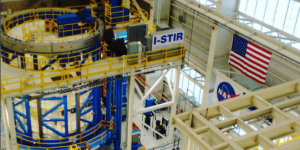
FOR ROCKETS GOING FARTHER THAN EVER, YOU NEED THE BEST AND BIGGEST TOOLS
Among NASA Michoud's unique gear: A 170-foot-tall, 78-foot-wide welding tool.
The weather offered an apt metaphor for Boeing’s recent fortunes in aerospace. The company has a big piece of every single one of NASA’s human spaceflight programs. It’s also the prime contractor of the Space Launch System’s core stage as well as for International Space Station operations, and Boeing is one two participants in the commercial crew program to deliver astronauts to the space station.
But clouds loom, too. SpaceX and Blue Origin have begun to demonstrate the viability of reusable rockets, leading to questions about the affordability of large, expendable rockets like the SLS. NASA will also likely drop funding for the station in 2024, or 2028 at the latest, and as the space agency moves on to cislunar space it is not clear Boeing will be the prime contractor on NASA’s next orbital outpost. Finally, Boeing’s Starliner is in a tight race with SpaceX’s Dragon spacecraft to be the first to reach the launch pad for commercial crew in roughly two years.
“If everything goes well, we’ll meet our schedule,” Ferguson said of the Starliner’s development, which as all new spacecrafts do, faces the pitfall of unknown unknowns. “As this begins to come to life, we’re keeping our fingers crossed we’re doing it the right way. Are we going to find one of those things that we didn’t think about? Or is it all going to go swimmingly?”
Overcoming delays
Ars had come to Boeing’s offices in the Clear Lake area, just four miles down the road from Johnson Space Center, to see its new training facility for the Starliner, formerly known as the CST-100 spacecraft. The company’s Space Training, Analysis and Review, or STAR Facility, will offer simulators and labs to train both astronauts and flight controllers. That’s because, as part of their commercial crew contracts, Boeing and SpaceX will bear primary responsibility training crews for the first time in NASA’s history.
Lee Hutchinson
On Tuesday, Boeing had a ceremony to officially open its new Space Training, Analysis and Review, or STAR Facility.
A short ceremony to mark the facility’s official opening was attended by politicians such as Texas Congressman Brian Babin, whose district includes Johnson Space Center. Afterward, Ars sat down to talk with John Elbon, vice president and general manager of Boeing’s Space Exploration programs. We were eager to ask about the company’s recent acknowledgement that the first crewed flight of Starliner would slip from October, 2017, to February, 2018. Prior to that announcement, there was talk in the aerospace community about both Boeing and SpaceX having trouble meeting NASA’s preferred timeline of the end of 2017, but so far only Boeing has publicly addressed those challenges.
“Our philosophy as a company like Boeing is that we’re going to be transparent with what we’re doing,” Elbon said. “The schedule we have now laid out is one which we have a legitimate chance of making. I can’t speak to what the other guys do.”
In recent years, NASA has blamed delays in the commercial crew program on under-funding from Congress, and the shortfall between what President Obama asked for and Congress provided has exceeded $1 billion since 2011. The agency has said Boeing and SpaceX would probably have launched by the end of 2015 had Congress provided full funding. Elbon, however, did not blame legislators for the recently announced delay.
“This is a development program and development programs are always difficult,” he said. Engineers are still struggling to limit the spacecraft’s mass, and when they tested a model of the Starliner mated to the Atlas 5 rocket in a wind tunnel, they discovered some aeroacoustic issues with flow around the vehicle. Boeing is now working to modify the vehicle’s exterior lines to get the airflow just right, and Elbon said the company believes it has a good plan to address this problem.
Another big hurdle is qualification testing, a procedure that verifies the design and manufacturing process. With the spacecraft’s avionics system alone, there are more than 200 boxes that various suppliers are building, and those must be assembled, integrated, and tested by both Boeing and NASA to ensure that they work.
Getting there
But the end is in sight. Boeing has made deposits with the United Launch Alliance to use its Atlas V rocket for four launches—an uncrewed test flight in late 2017, a crewed test flight in 2018, and the first two service missions for NASA to follow.
FURTHER READING

QUIETLY, THE NEW SPACE RACE BETWEEN SPACEX AND BOEING BURNS HOT
Whichever company flies astronauts first in 2017 gains bragging rights.
Meanwhile Elbon knows that SpaceX is working just as hard with its own rocket and spacecraft, to claim bragging rights as the American company which ended the country’s dependence on Russia for rides into space. “I sometimes characterize this as a competition, but it’s like a golf match,” he said. “You just have to play your own ball, and play the course. You can’t worry about playing the other guy. We want to win, and we’ll see what’s on our scorecard when we get to the 18th hole.”
After our interview with Elbon we found Ferguson, the three-time astronaut, outside in the sunshine. Since leaving NASA in 2011, his role at Boeing has been to ensure the spacecraft’s controls are flier-friendly, and he recently became deputy director of the Starliner program. He agreed with Elbon that probably the biggest leap before flight is getting through all of the qualification testing.
“A lot of it is out of our hands in some sense, with the suppliers,” he said. “We have a lot of components being made, many of which are first-time designs. Getting them through the qualification tests and getting them into the vehicle, I think that’s the long pole.” Then, he added, “It’s really hot now. I think we should go back inside.”
We did.
READER COMMENTS 88
Eric Berger / Eric Berger is the senior space editor at Ars Technica, covering everything from astronomy to private space to wonky NASA policy. Eric has an astronomy degree from the University of Texas and a master's from the University of Missouri. He previously worked at the Houston Chronicle for 17 years, where the paper was a Pulitzer Prize finalist in 2009 for his coverage of Hurricane Ike. A certified meteorologist, Eric lives in Houston.
@SciGuySpace on Twitter| ← OLDER STORY | NEWER STORY → |
Subscribe to:
Posts (Atom)





